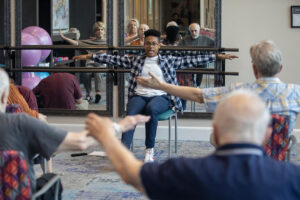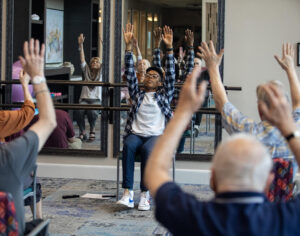How One Senior Care Community Is Using Exercise to Fight Parkinson’s
According to the Parkinson’s Foundation, nearly one million people in the United States live with Parkinson’s disease today, and by 2030, as many as 1.2 million people could live with the disease. Parkinson’s, a neurodegenerative disease, increases in incidence with age, and nearly 90,000 people are diagnosed with the disease each year.
To provide support for residents living with Parkinson’s disease, The Providence, a senior living community in Fairfax, Virginia, has implemented an exercise program aimed at improving the quality of life for residents living with the disease. Through a specially designed exercise class, the community empowers them to improve their mobility, enhance their physical capabilities, and potentially slow the progression of the disease.
The Role of Exercise in Fighting Parkinson’s
A study published in the International Review of Neurobiology examined the effects of physical therapy and exercise including brisk walking, gait training with a treadmill, Tai Chi, dance, and more. According to the study, every treatment intervention led to short-term benefits, while some interventions led to long-term benefits. For example, Tai Chi produced benefits for six months, dance therapy produced benefits for 12 months, and progressive resistive training produced benefits for 24 months, helping to alleviate Parkinson’s disease motor symptoms.

Charity Hammond (center), wellness coordinator at The Providence
Additionally, the Parkinson’s Outcomes Project, a clinical study of more than 13,000 participants in five countries, found that increasing physical activity to at least 2.5 hours per week could slow the decline in a person’s quality of life. The study also found that exercise could alter the course of Parkinson’s disease.
“Research has shown that exercise can improve motor and non-motor symptoms of Parkinson’s,” says Charity Hammond, wellness coordinator at The Providence. She notes that exercise may result in decreased depression and anxiety, improved sleep quality, improved gait and balance, a decrease in the amount of falls, improved flexibility and posture, and more. “Although the symptoms vary by individual, some things I’ve heard from residents in my class are that they have more energy after the class, they feel ‘less stiff’ since starting the class, and that it’s been great meeting new people,” Hammond explains.
Designing an Exercise Class to Support Residents with Parkinson’s Disease
The Providence partners with the Parkinson’s Foundation of the National Capital Area (PFNCA) in Washington, DC on several projects. The Providence management asked Hammond if she would be interested in starting an exercise class for individuals with Parkinson’s disease. Though Hammond hadn’t previously run such a class, she gladly accepted. Hammond completed a process in which she learned how to be an instructor through the PFNCA.
“Once that process was done, I had access to a plethora of exercise class videos that have been and are being held online through PFNCA,” she explains. “I also found a great organization called Power for Parkinson’s that creates amazing YouTube workout videos. Through using those resources, and adding my own spin to things, we have the class that I lead at The Providence of Fairfax.”
 Hammond began offering the class in mid-November 2022. All of the exercises are designed so that participants can perform them while seated. “We focus on doing the exercises with very exaggerated movements that use the individual’s full range of motion, so that they’re working hard to keep the mobility they have left,” says Hammond. “I also add in a lot of cross-lateral movements, like raising the right arm while raising the left knee, because that challenges the participants to use both sides of their brains in equal amounts.” She also has participants count backwards by twos or name different kinds of cars with some exercises, which helps with cognitive function.
Hammond began offering the class in mid-November 2022. All of the exercises are designed so that participants can perform them while seated. “We focus on doing the exercises with very exaggerated movements that use the individual’s full range of motion, so that they’re working hard to keep the mobility they have left,” says Hammond. “I also add in a lot of cross-lateral movements, like raising the right arm while raising the left knee, because that challenges the participants to use both sides of their brains in equal amounts.” She also has participants count backwards by twos or name different kinds of cars with some exercises, which helps with cognitive function.
“So far, residents think the class is challenging, but in a good way,” Hammond notes. “It not only challenges them physically, but cognitively as well.”
Tips for Starting Your Own Exercise Program
Hammond encourages anyone who doesn’t have extensive knowledge of Parkinson’s to ask plenty of questions and research information about the disease. “Be confident in yourself and your abilities, and be on the lookout for resources that will help you develop your program,” she recommends.
“Beginning a program is a great step and will most likely provide a sense of community for those who have Parkinson’s in your community,” Hammond explains. She notes that the exercise class at The Providence is open not only to residents, but also to anyone in the Fairfax, Virginia community living with Parkinson’s.

Paige Cerulli is a contributing writer to i Advance Senior Care.
Related Articles
Topics: Facility management , Featured Articles , Operations











